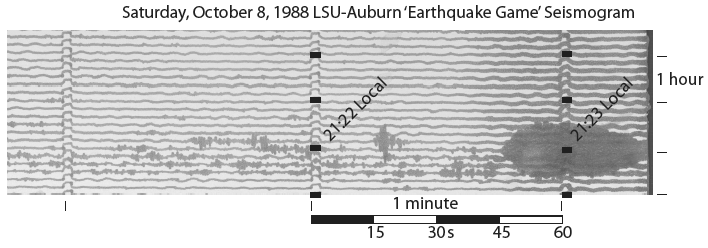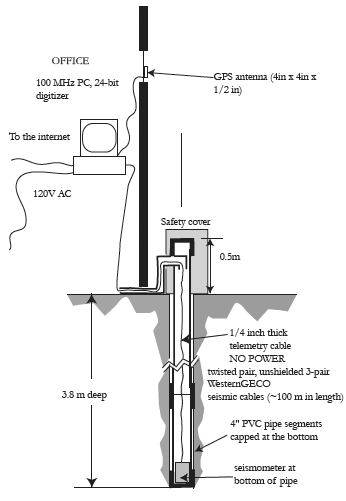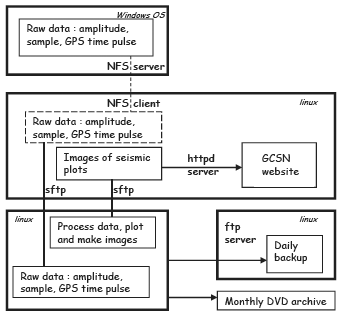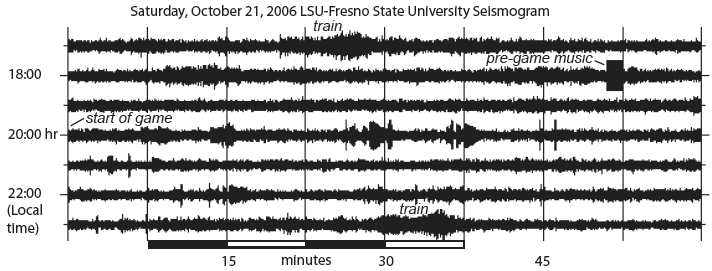| Publications: SRL: EduQuakes |

EduQuakes
May/June 2009
Seismology in Sport
Juan M. Lorenzo
Louisiana State University, Baton Rouge
SPORTING CHALLENGE AND OPPORTUNITY
Large class sizes of several hundred students at U.S. public universities offer an exciting opportunity to create first-time interest in geophysics among many non-science majors who would not ordinarily experience earth sciences. Natural events such as earthquakes, landslides, and volcanic eruptions can be used to captivate students in these large classes through the empathy generated by the effects of these disasters on fellow humans. Sporting events can also be used as “teachable moments” in large classes but have, until now, received less attention. When David Beckham scores a soccer goal, the curved trajectory of the ball can be used to explain aerodynamic principles (Inside Science News Service 2003). Sporting events can serve to teach basic science facts, including seismological principles, because sports resonates with people of many ages and social groups across entire nations and even continents. When goals were scored by the Cameroon National Football Team during the 2006 African Cup of Nations, excited spectators created high-frequency tremors (>1 Hz) that registered simultaneously across the whole country (Euler et al. 2007).
THE “EARTHQUAKE GAME” OF 1988
In the United States, American-style football is popular among all age groups and is played in high schools, colleges, and professionally. At my university, Louisiana State University, football and seismology have been inexorably intertwined for more than 20 years, thanks to the legendary “Earthquake Game” of 1988. During the final minutes of a game against Auburn University, the LSU home team turned the game around from a 6-0 loss into a 7-6 win with a final and unexpected touchdown. Fans in the stadium erupted into deafening cheers. A nearby (~1 km distant), shallow borehole (<4 m) 1-Hz geophone administered by the Louisiana Geological Survey (D. Stevenson, personal communication 1988) detected this noise. Local legend attributes an anomalous increase in ground motion detected at the seismograph to these cheers (Figure 1).

▲ Figure 1. Paper record image of prolonged tremor activity associated with an American football game at nearby Louisiana State University. The most notable event begins at about 21:22:45 hr (local time), lasts ~30 s, and is associated with a winning touchdown a few minutes before the end of the game (LSU Center for Coastal, Energy and Environmental Resources 1988). Click image to view at larger size.
A LOCAL EDUCATIONAL SEISMIC NETWORK
Local, low-cost seismological networks exemplify one effective model of earth science education in the United States and abroad (Hamburger and Taber 2003). Educational seismological networks can capture the interest of students because the data they collect can raise awareness of relevant societal problems including water resources management and earthquake hazards. Additionally, students and instructors involved in the installation of the network gain a permanent sense of institutional ownership.

▲ Figure 2. Seismograph layout presented to the university engineers. Station location based on averaged GPS data collected continuously over a period of one week at 30.4120450 N and 91.1792067 E, ~60 m NAD88 from BJ4051 National Geodetic Survey Marker, 3.8 m below ground level. The horizontal accuracy from GPS is estimated to be ±10 m. For documentation detailing the history, materials and costs of this seismometer installation see http://www.geol.lsu.edu/jlorenzo/GCESN/index.html.
Click image to view at larger size.
During 2005–06, the opportunity to turn local legend into a teaching tool led to the installation of a borehole seismometer at LSU in Baton Rouge (Figure 2). The prototype station, named Gulf Coast Educational Seismic Network LSU1, is located adjacent to the Department of Geology and Geophysics immediately outside a large teaching hall ~300 m from the football stadium. Data during football games is collected by a Mark Products L-4C 1-Hz vertical-component geophone, suitable to local seismic “events,” either natural or human-induced, that have not suffered significant attenuation because their travel path is relatively short (< few hundred m).
This prototype system (Figure 3) is made up of readily available, low-priced, independent software and hardware components (Lorenzo 2003). Additional inexpensive educational seismograph models also exist (Braile 2001). Our recorder introduces GPS timing and a Lawson Labs 24-bit analog-digital card. A vintage personal computer (120 MHz) is sufficient to control 100 samples/second via a TCP/IP card. A one pulse/ per second timing signal (10–25 ms accurate) is recorded in the data stream and is taken from a GPS unit (Motorola Oncore UT). Data text-files are sent via the Internet for Webcasting. A simple, server software written in the Perl scripting language, for Linux OS to process, archive, and generate plots using open source mapping software (Wessel and Smith 1998), is available for free from the author. All the software tools are in the public domain.

▲ Figure 3. Network topology of prototype on-campus educational borehole seismograph system. Click image to view at larger size.
As expected, more environmental noise is generated during weekday, daytime hours when classes are in session, but an on-campus location within immediate proximity of power and an Internet connection removes the need for additional telemetric tools. Data is transmitted along an unshielded, twistedpair geophone field cable nearly 100 m long.
TIMING ACCURACY
GPS receivers often provide a precision pulse per second (pps) timing output, as well as standard output frequencies in the MHz range. Currently, in our system, timing accuracy is limited by firmware (upgradable) plus the accuracy of the internal PC clock, which is corrected in software every second to within ±10 ms of the GPS pps. Recently, other commercial low-cost systems have become available (e.g., http://www.symres.com) with a comparable or better timing solution.
CLASSROOM USE OF FOOTBALL SEISMOGRAMS
A major advantage for first-time instruction of seismology in physical geology classes at the bachelor’s degree level, especially in non-majors’ classes, is that most if not all new students are already familiar with local football culture and footballinduced earth tremors and seismic recordings. Anecdotally, even new foreign students are keenly aware of American football. In classes with as many as 350 students, I use the football seismograms to teach scientific methodology, as well as content, on earthquakes and earth structure. Various examples of gameday seismograms from the 2006 and 2008 seasons are available for online viewing (http://www.geol.lsu.edu/jlorenzo/GCESN/index.html). Because most students are inexperienced with spectral analysis, observations are limited to discriminating and describing events in the time domain.
Examination of a typical game-day seismogram yields three notable events (Figure 4). First, the highest amplitude portion of the seismic record appears before the start of the game and lasts less than five minutes. These high-amplitude data appear and end sharply over short intervals (1–2 minutes) of time. Traditionally, about 1–1.5 hours before the start of each game, a large musical band marches outside the football stadium. An event with identical characteristics appeared in the 1998 seismogram and in all subsequent recordings. Musically sourced tremors are rich in 1–2 Hz frequency data (Green and Bowers 2008). Two similar events, which last more than seven minutes each, appear early and late in the record of Figure 4 and correlate with the slow passage of local freight trains within a few hundred meters of the stadium where the game is played. Amplitude variations are probably related to the changing distance of the train moving past the borehole geophone. During the first hour after the start of the game several short-lived events of less than one minute each share the sharp initiation character of the interpreted “musical band” event but the trailing character of the “train event.” These last events may be initiated by musical band activity but decay in strength in a manner perhaps more related to a tapering cheer from the spectators. As a result of student-instructor interaction, additional testable interpretations can be provided and appropriately used to exemplify the use of multiple working hypotheses (Chamberlin 1897).

▲ Figure 4. A representative seismogram of an American football game showing several key interpretable events used for initiating class discussions in introductory geosciences classes as well as signal theory analysis in more advanced classes. Interpreted events are indicated at various times throughout the seismogram. Click image to view at larger size.
The above exercise in observation and description could benefit from additional seismograph stations in the network, each with more than a single vertical-component seismometer. However, certain sophisticated concepts of earthquake wave propagation may still be introduced using the available records—for example, the mode of wave transmission through the stadium structure and ground or via ground-air coupling, or the concept of geometric spreading, which can explain variations in the strength of seismic arrivals generated by the motion of a train. The concept of waveform energy can be introduced to explain the variable root mean square energy in seismic events during the six-hour duration of the game tremors in Figure 4.
Advanced classes in seismology or geophysics, aimed at final-year undergraduate students and first-year graduate students, can incorporate game-day seismograms in classroom activities on spectral analysis. Taber (2009) provides a good initial example that uses both artificial and earthquake data and can readily be adapted to digital versions of game-day seismograms. Matlab is a commonly used commercial package designed to manipulate and plot all sorts of data, but other free, high-level computational packages exist (http://www.orfeus-eu.org/Software/software.html). For example, GNU Octave (http://www.gnu.org/software/octave/), a free high-level language primarily intended for numerical computations, is mostly compatible with Matlab. Instructional goals can readily include experimenting with Nyquist frequency, sampling rate, digital filtering, Fourier analysis, and synthesis.
CONCLUSIONS
Modern scientific data acquisition tools, and accompanying methods of quantitative analysis, are inherent to the field of seismology and are readily applicable for teaching fundamental scientific communication and thinking skills. The communities in which we teach may each have different popular sporting events that we can use to spread awareness of the relevance of seismology, and more broadly science and mathematics, in our everyday lives. In Venezuela it may be baseball, in Australia it could be a form of rugby, in Pakistan cricket, and in Spain, soccer. To record sport-induced tremors, the maturing electronic industry and second-hand market provide off-the-shelf components that are cheap and readily available. A 24-bit-precision local seismic network can be established for under $1,000. In campus settings we have the advantage of short cable distances to Internet links and digitizers. Sport activities recorded on such seismograph systems generate an opportunity to make seismology more relevant to our daily lives and in particular, to raise more scientific awareness in our students.
ACKNOWLEDGMENTS
This project was funded by the Society of Exploration Geophysicists Foundation and by the Department of Geology and Geophysics at Louisiana State University through its chairman at the time, Brooks Ellwood. The educational component of this project also drew support from numerous public, state, and private entities inside and outside my university. I owe special thanks to Don Stevenson, who identified the original 8 October 1988 “earthquake” from the LSU-Auburn football game and advised me on the drilling procedures and borehole seismometer installation. Chacko John, director of the Louisiana Geological Survey, made available a hydraulic drill, electronic measurement devices, and borehole seismometers. I also thank WesternGECO for its donation of geophone seismic cables. Facilities Services at Louisiana State University freely supported the borehole installation with materials and labor.
REFERENCES
Braile, L. (2001). Educational Seismograph Purdue University; http://web.ics.purdue.edu/~braile/edumod/educseis/educseis.htm.
Chamberlin, T. C. (1897). Studies for students: The method of multiple working hypotheses. Journal of Geology 5, 837–848.
Euler, G. G., D. A. Wiens, and K. M. Lofton (2007). Footquakes. IRIS Newsletter 1, 13; http://www.iris.edu/news/IRISnewsletter/2007/1/2007_Issue1NewsletterWeb.pdf.
Green, D. N., and D. Bowers (2008). Seismic raves: Tremor observations from an electronic dance music festival. Seismological Research Letters 79, 546–553.
Hamburger, M. W., and J. Taber (2003). Toward integration of educational seismology programs: The U.S. educational seismology network. Seismological Research Letters 74, 603–604.
Inside Science News Service (2003). The physics behind Bend it Like Beckham. American Physical Society News 12, 1.
Lorenzo, Juan M. (2003). A proposed network for Louisiana public high schools—SeisMEAUXgraph. Gulf Coast Association of Geological Societies 53rd Annual Convention, Baton Rouge, 53, 488.
LSU Center for Coastal, Energy and Environmental Resources, 1988, Seismogram RG# A0402: Baton Rouge LA, LSU Libraries, Baton Rouge, LA.
Taber, J. (2009). Introduction to Spectral Analysis and Matlab; http://www.iris.edu/hq/resource/introduction_to_spectral_analysis_and_matlab.
Wessel, P., and W. H. F. Smith (1998). New, improved version of the Generic Mapping Tools released. Eos, Transactions, American Geophysical Union 79, 579.
[Back]
| HOME |
Posted: 29 April 2010
